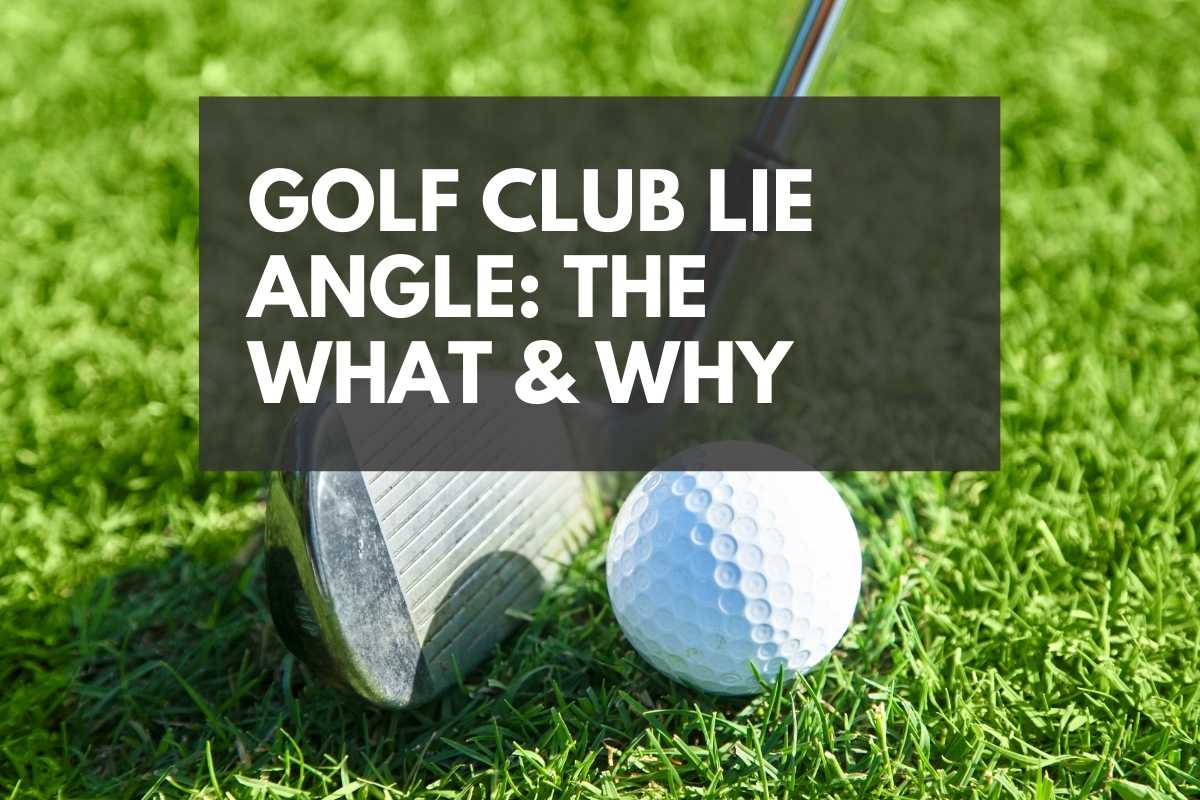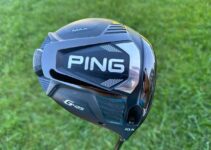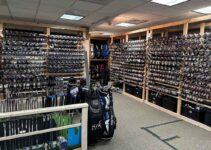Many golfers play the game without ever thinking about golf club lie angle. However, the lie angle of your golf clubs plays a significant part in your performance.
You increase the chances of hitting solid shots when the golf club lie angle is correct for your swing. That can impact your distance, accuracy, shot shape, and consistency.
For instance, you’re more likely to connect with the heel when the lie angle is too upright for your swing. Your divots will point left (for right-handers) and lead to ugly crossover pull shots and even shanks if you impact the hosel.
You’ll make toe contact with the ball if your lie angle is too flat. That pushes the ball right of the target line (for right-handers) and results in suboptimal contact.
What is Lie Angle?
Lie angle is the measurement between the hosel/shaft and the ground when the clubhead rests flat (or when the grooves are parallel to the floor).
Golf club lie angle is measured in degrees, so a standard driver might have a lie angle of 58 degrees.
The correct lie angle for your setup ensures the sole of the club is square when it interacts with the turf. That helps you get clean contact without the heel or toe hitting the ground first.
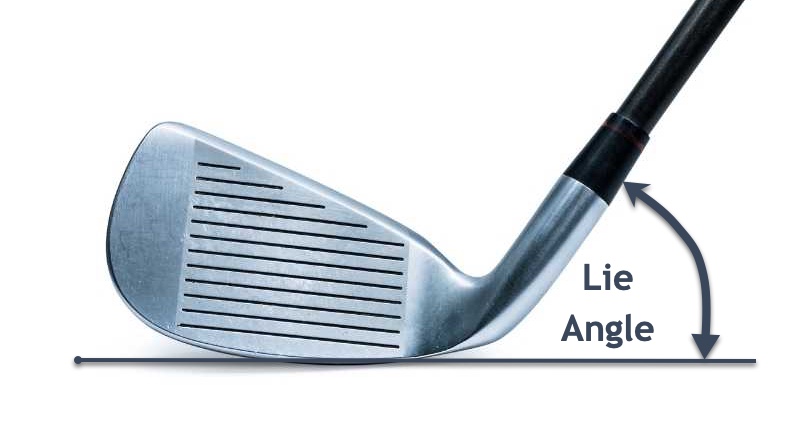
Each club in a standard set will have different lie angles. The lie angles of a 5-iron and 9-iron are different – unless you use an iron set with single-length shafts.
Longer clubs have flatter lie angles, while shorter clubs have more upright lie angles. So, your hybrid might have a 60-degree lie angle, but your wedge might have a 64-degree lie angle.
Standard Lie Angle for Clubs
The chart below shows the standard lie angle range for drivers, hybrids, irons, and wedges.
| Club | Lie Angle in Degrees |
| Drivers | 56-60 |
| Hybrids | 57-60 |
| Irons | 61-63 |
| Wedges | 63-64 |
Three Types of Lie Angles
There are three types of lie angles: standard, upright, and flat. Using clubs with lie angles that are too upright or too flat for you will cause problems.
Standard Lie Angle
A standard lie angle is when the sole rests flat on the ground, and the shaft leans at a standard angle. If you have ever bought a set of golf clubs straight off the rack (without being fitted), you probably purchased standard lie angle clubs because these are the most commonly sold in golf stores.
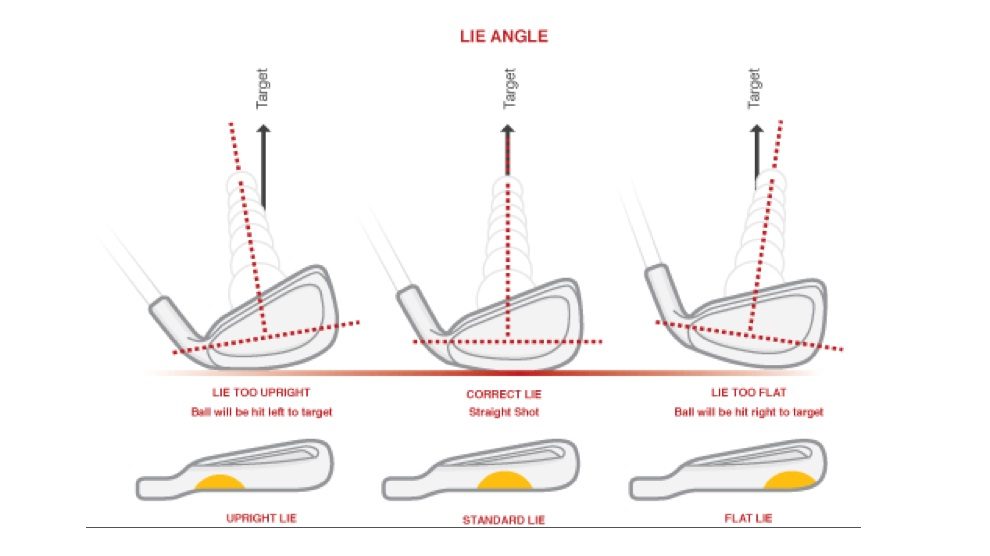
Upright Lie Angle
An upright lie angle is when the shaft sits in a more upright position as the clubhead rests on the ground. Clubs with an upright lie angle are common among taller golfers. The upright angle ensures their hands are in a comfortable position at address.
Flat Lie Angle
A flat lie angle is when the shaft sits in a flatter position as the clubhead rests on the ground. Shorter players tend to need clubs with a flat lie angle. However, it also depends on your swing.
What Happens When You Use the Incorrect Lie Angle?
An incorrect lie angle will either be too upright or too flat for your setup and swing.
Too Upright
An upright lie angle will prompt you to hold your hands higher to keep the sole flat on the ground. However, that goes against your natural tendency if you address the ball with your hands positioned lower.
Let’s say you set up with your hands upright at address to account for the upright lie angle, and the sole is flat. That will change once you swing the club.
You’ll come into your usual position at impact with your hands lower. Your body will do it automatically without you even knowing.
Now, picture resting the sole flat on the ground and then lowering your hands. The result is that the heel comes to rest on the ground while the toe lifts into the air.
You’ll be at that position at impact when you swing a club that’s lie angle is too upright for you. It leads to heel contact with the ball, meaning you’ll hit shots left of the target if you’re a right-hander.
Too Flat
A flat lie angle will prompt you to hold your hands lower to keep the sole flat on the ground. That goes against the natural tendency for players who keep their hands higher at setup.
These players will hunker down more in their setups to keep the sole flat. It’s an unnatural position for them to hit the ball. You might be one of these players.
Your body will compensate for the unnatural position when you swing. You’ll naturally lift your hands higher when you’re impacting the ball. It might be minimal, but it’ll happen.
Lifting your hands causes the heel to rise off the ground. So, the toe of the club connects with the turf on impact.
That leads to toe contact with the ball when you strike it. You’ll hit shots right of the target if you’re a right-hander.
Why You Need the Right Lie Angle
Golf is hard enough to play even when you have all the right equipment. Using the wrong equipment will only make it harder on yourself.
Golfers should use the technology available these days to help them play better golf. It’s not hard to find the right lie angle for you, but you’ll need to do a professional fitting.
It’s worth it because your equipment will help you instead of hindering you. Golf can be frustrating enough without your equipment fighting against you.
A golf club that is off by a couple of degrees for your swing type may not sound like that big of a deal. However, that small difference can be the difference between a well-struck iron shot and a slice or hook.
It causes compensations in your swing and leads to off-center strikes. Getting the right lie angle will lead to more consistent ball striking.
Also, newer golfers must get the lie angle right. The wrong lie angle can lead to swing compensations and cause you to develop bad habits. Some of these bad habits might take years to fix down the line.
How to Check if You’re Using the Right Lie Angle
You can use a launch monitor, a professional fitter, or a magic marker to check if you’re using the right lie angle.
Launch Monitor
Some launch monitors track the position of your club at impact. The lie angle is one of the metrics a launch monitor can track. You can do this with your own launch monitor or one at a facility.
Professional Fitter
A professional fitter can check your lie angle using a lie board. You hit a ball from the board with a sticker on the sole of the club. Hitting a shot impacts the board and makes a mark on the sticker, showing if you have the right lie angle.
Magic Marker
You can check the lie angle yourself with a magic marker. Draw a thick line on a golf ball with the marker. Then, place the ball on the ground with the line in a vertical position, ensuring it lines up with your intended target.
The ball will leave a mark on the club when you hit it. Your lie angle is too upright if the line faces to the right, while it’s too flat if it goes to the left.
Can You Get the Lie Angle Adjusted in Your Irons?
Yes, you can get the lie angle adjusted in your irons. However, you need a machine to bend the clubs and should always get a professional to do it. Cast irons are harder to bend than forged irons.
Cast Irons
These irons are made from cast steel and are harder to bend. The material and molding process doesn’t leave much room for movement.
You can get cast irons adjusted by about one or two degrees. Overdoing it can cause the irons to break.
Forged Irons
Forged irons are forged into position with a press instead of being made from a mold. That makes it easier to bend these irons. You can get them adjusted more than cast irons without worrying about breaking them.
What Lie Angle Should My Clubs Be?
That question depends on many factors. You must get your swing checked with the clubs you are currently using. You can learn a great deal by using the impact board and the marker trick.
However, it’s best to seek a professional club fitter so that you can enjoy the best possible results on the course. If you are in the market for a new set of golf clubs, the fitting is free as long as you commit to buying.
Most club fitters will use the impact board and tape to determine what lie angle you need. However, modern-day technology like launch monitors have enabled golfers to precisely study and pinpoint what’s occurring when they impact the golf ball.
Conclusion
Golf club lie angle plays a significant part in your performance on the golf course. The right lie angle helps you make the best possible contact with the ball.
You’ll connect with the heel when your lie angle is too upright, causing shots to go left of the target. A lie angle that’s too flat means you’ll strike the toe and hit shots right of the target.
You can check your lie angle on a launch monitor or with a magic marker. However, it’s always best to visit a professional to get the perfect lie angle for your swing.

